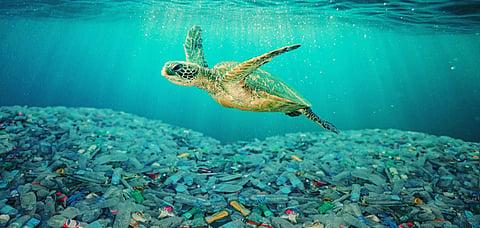
- Destinations
- Experiences
- Stay
- What's new
- Celebrating People
- Responsible Tourism
- CampaignsCampaigns
- Subscribe
- Buy Now

Do you know what environmental scientists call the popular sailing route between California and Hawaii The Great Pacific Garbage Patch. Surprised But this is only the tip of the iceberg.
According to an article by NASA&rsquos Earth Observatory, &lsquoabout eight million tons of plastic flow from rivers and beaches into the ocean every year&rsquo. The debris include a variety of objects, ranging from large fishing nets to microplastics (plastic pieces smaller than 5mm). Carried by ocean currents and broken down by waves and sunlight, the microplastics accumulate as huge garbage patches in the calm centers of ocean gyres (rotating ocean currents). The debris not only spreads across the surface of the water but also drops down all the way to the ocean floor. Harming the marine ecology in the long run.
According to the NOAA Marine Debris Program, marine debris found in garbage patches can impact wildlife in a number of ways. Certain types of debris can injure or kill marine life. Animals get trapped or entangled in lost or abandoned fishing nets (ghost nets). Plastic debris such as packing straps, six-pack rings, handles of plastic bags, etc., which come with loops  injure wildlife. Studies have shown how animals mistakenly eat plastic and fill full, and consequently refrain from eating real food. If marine life such as algae, barnacles, crabs or other species attach themselves to the marine debris, they may get carried away to new environments invasive species can do harm to native species and disrupt the ecological balance. Scientists are also conducting studies to understand the impact of marine garbage patches on human life.
Scientists usually study the marine garbage patches by pulling a net behind a boat. However, this method may not always be possible and also suffers from gaps in information. It is expected that a new method developed by researchers at the University of Michigan (UM) to map the concentration of ocean microplastics around the world may provide more accurate information. NASA&rsquos Interagency Implementation and Advanced Concepts Team (IMPACT) is also developing a method to detect ocean debris and plastics through machine learning.
According to the Earth Observatory article, the UM researchers found that analysis of signals sent out by the Cyclone Global Navigation Satellite System (CYGNSS) not only helps to study ocean wind speeds but also reveal the presence of plastic. The data was studied and compared with other relevant information by Chris Ruf, principal investigator of the CYGNSS mission (and one of the authors of the published research), and UM research assistant Madeline Evans.
It is said that a lot of the plastic found in the ocean are actually coming from the world&rsquos rivers. Interestingly, when Ruf and Evans Ruf created time-lapse views of all of the major rivers in the world, they found large amounts of microplastics were coming from the Yangtze and the Ganga.
Nearer home, a recent report in the Hindustan Times mentioned how fisherfolks living along Mumbai&rsquos coast and the Arabian Sea &lsquoare losing access to fishing commons and livelihoods due to plastic pollution&rsquo. The report has also quoted fishermen saying that &lsquowhile hauling fish, they end up with several kilos of plastic waste which takes hours to segregate from the catch&rsquo. The plastic often damages their nets too.
A post-pandemic report published by the United Nations Environment Programme (UNEP) has revealed the world&rsquos addiction to single use plastic. According to the report, &lsquoone million plastic drinking bottles are purchased every minute across the globe, while 5 trillion single-use plastic bags are used worldwide every year. In total, half of all plastic produced is designed to be used only once &mdash and then thrown away&rsquo. The report also highlighted that if the current trend continues our oceans could contain more plastic than fish by 2050.
The COVID-19 pandemic has delivered a tremendous lesson &ndash to survive the world has to devise sustainable and inclusive methods to do business. Reducing the use of plastic is no less important than controlling climate change, warn environmentalists.
